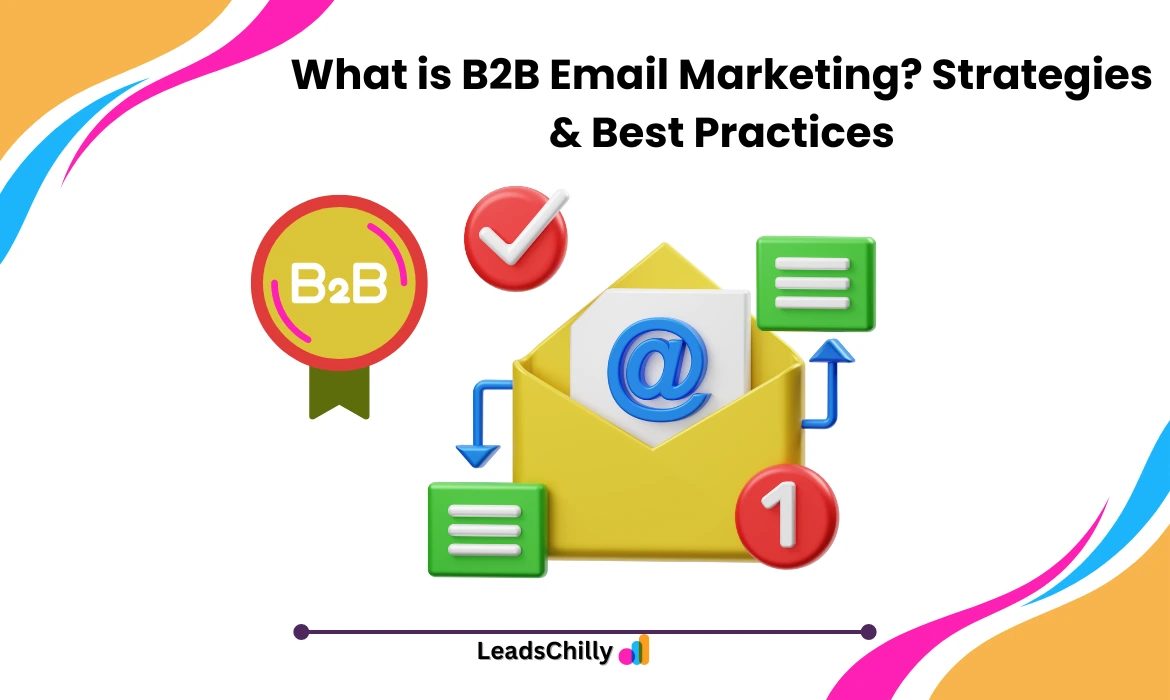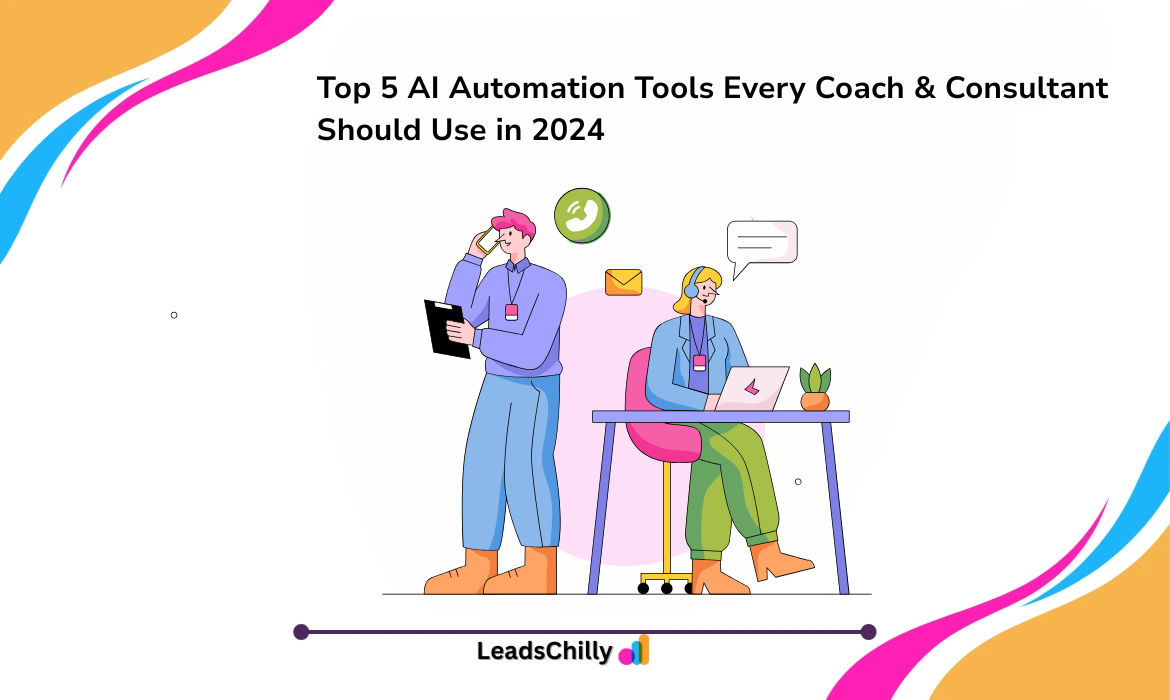B2B Email Marketing is a targeted communication strategy where businesses use email to reach out to other businesses. This approach helps companies build relationships with decision-makers, nurture leads, and boost conversions. Unlike B2C emails that focus on direct sales to individual consumers, B2B emails tend to prioritize longer sales cycles, multiple decision-makers, and high-value propositions.
Did you know? According to a report by Campaign Monitor, “email marketing is responsible for generating $42 for every $1 spent, making it one of the most cost-effective B2B marketing channels available“. This highlights how impactful email marketing can be when implemented correctly.
Start today and boost your email marketing ROI with LeadsChilly! Try our 14-day free trial or book a demo to see how we can help you streamline your email automation and increase conversions.
What is B2B Email Marketing?
B2B email marketing refers to the practice of using email as a direct channel to communicate with other businesses. The goal is to engage with potential clients, build relationships, and convert prospects into long-term customers. B2B emails are typically more informative and professional compared to B2C emails, as they are often sent to decision-makers or senior leaders within an organization.
Key Differences Between B2B vs. B2C Email Marketing
B2B and B2C email marketing differ significantly in terms of approach, messaging, and target audience. B2B emails focus on delivering value and building long-term relationships, whereas B2C emails are designed for quick, transactional actions.
In B2B marketing, the decision-making process often involves multiple stakeholders, requiring tailored messages that resonate with each decision-maker’s role and needs.
- Target Audience:
- B2B: Targets decision-makers and influencers in businesses.
- B2C: Targets individual consumers based on personal preferences.
- Message Tone:
- B2B: Professional, value-driven, and solution-oriented.
- B2C: Casual, more emotional, and often limited to a direct call-to-action.
- Sales Cycle:
- B2B: Long, multi-stage buying process with multiple decision-makers.
- B2C: Shorter, impulse-driven buying decisions.
B2B Sales Definition
B2B sales refer to the process of selling products or services from one business to another. This sales model is driven by relationship-building and a focus on offering value that helps solve business problems. Unlike B2C sales, which are often transactional, B2B sales involve a deeper engagement and a more personalized approach.
Key Aspects of B2B Sales
B2B sales are unique in that they are highly relational and typically involve a longer sales cycle. Establishing trust and rapport with potential clients is critical, as is demonstrating the value your product or service brings to their business. Here are the key factors:
- Relationship Building: In B2B sales, trust is everything. Building strong, long-lasting relationships with key decision-makers is essential.
- Long Sales Cycle: B2B sales often take time, sometimes months, as multiple decision-makers may be involved. Patience and persistence are key.
- Value-Driven Approach: B2B decisions are often made based on ROI and how the product or service will benefit the business in the long run.
B2B vs. B2C Sales
The difference between B2B and B2C sales lies primarily in the buying decision-making process. In B2B, the decision is typically made by a group of people, and the process takes longer due to the need for negotiations, comparisons, and approvals. In contrast, B2C sales are usually quicker, with individual consumers making faster, emotion-driven purchases.
Benefits of B2B Email Marketing
B2B email marketing offers a variety of benefits that can significantly impact your business’s growth. Not only does it offer a cost-effective means to communicate with prospects and clients, but it also helps you build strong relationships, increase conversions, and track performance easily.
Key Benefits of B2B Email Marketing
- Increased ROI for B2B Email Campaigns:
Email marketing offers one of the highest returns on investment compared to other digital marketing channels. By sending targeted emails to highly qualified leads, B2B companies can improve their conversion rates and see significant increases in ROI. - Better Targeting and Personalization:
With email marketing, you can segment your audience based on key criteria like industry, role, behavior, and more. This ensures that your emails are tailored to the recipient’s needs, increasing their relevance and effectiveness. - Strengthening Relationships with Decision-Makers:
Consistent and valuable communication with decision-makers helps establish trust. Over time, this can result in higher conversion rates and long-term client relationships.
Types of B2B Emails
There are several types of B2B emails that businesses use to engage with their audience. Each serves a distinct purpose, from generating leads to retaining customers.
1. Lead Generation Emails
These emails are designed to capture new leads and build your contact list. They often involve offering free resources, like whitepapers or webinars, in exchange for contact information.
- Welcome Emails: A great way to greet new subscribers and set expectations for future communications.
- Lead Nurturing Emails: Keep your leads engaged with valuable content and insights that move them closer to making a purchase decision.
2. Sales-Driven Emails
Sales emails focus on converting leads into customers by promoting products or services. These emails might contain product announcements, demos, or special offers to push the recipient toward taking action.
- Cold Outreach Emails: Introduce your product or service to potential clients and initiate contact.
- Product Announcement Emails: Inform leads about new product offerings or updates to existing services.
3. Customer Retention Emails
Once you’ve acquired customers, it’s important to keep them engaged and satisfied. Retention emails help maintain strong relationships and encourage repeat business.
- Newsletters: Keep your customers informed about your business, industry news, or upcoming events.
- Re-engagement Emails: Win back inactive customers with personalized offers or new content.
B2B Email Marketing Strategy: Step-by-Step
A clear, structured strategy is the foundation of any successful B2B email marketing campaign. Here’s a step-by-step approach to ensure that you’re delivering the right messages to the right people.
1. Define Your Audience and Buyer Personas
Start by understanding who your ideal customers are. Develop buyer personas that outline their pain points, motivations, and the challenges they face. This helps you create personalized and relevant content.
2. Building Your Email List
Building a quality email list is crucial to your success. Use lead magnets, opt-in forms, and gated content to encourage prospects to join your list. Make sure to offer value upfront to entice them to sign up.
3. Segmenting Your Audience
Segment your list based on key characteristics like industry, job title, past engagement, or purchasing behavior. This allows you to send targeted and tailored messages to each segment, increasing your chances of engagement.
4. Crafting Compelling Email Copy
Your email copy should be concise, clear, and value-focused. It should address the recipient’s pain points, offer a solution, and provide a strong call-to-action (CTA) that encourages the next step.
5. Subject Line Optimization
Your subject line is the first thing your recipient will see. It needs to grab attention and make them want to open your email. Experiment with urgency, curiosity, and personalization to see what works best for your audience.
B2B Email Automation and Workflows
Email automation allows businesses to send timely, relevant messages at scale. It saves time, ensures consistency, and allows businesses to reach their audience at the right moment in
their buyer’s journey. Automated campaigns can also nurture leads and build deeper relationships without manual intervention.
Drip Campaigns and Their Role in Lead Nurturing
Drip campaigns involve sending a series of emails over time. These campaigns can be used to guide leads through the sales funnel, gradually providing them with more valuable information and offering solutions to their pain points.
Trigger-Based Emails for Personalized Outreach
Trigger-based emails are sent based on a recipient’s actions or behaviors, such as downloading a resource or visiting a specific webpage. These emails are highly relevant because they are personalized to the recipient’s interests and actions.
Best Platforms for B2B Email Marketing Automation
There are numerous platforms that help automate B2B email marketing campaigns. Some of the best platforms include:
- Mailchimp
- HubSpot
- ActiveCampaign
- Sendinblue
Best Practices for Writing B2B Emails
When writing B2B emails, there are several best practices that can improve engagement and drive better results.
Personalization and Relevance
Personalizing emails with the recipient’s name and other relevant details (like their company name or role) increases the likelihood of engagement. Make sure the content is tailored to their specific needs or interests.
Crafting Effective Subject Lines
A compelling subject line should be clear, concise, and offer value to the recipient. Experiment with urgency, curiosity, and personalization to see what resonates with your audience.
Keeping the Message Concise and Value-Focused
B2B recipients often don’t have time to read long emails. Keep your message brief, focusing on the value and benefits your product or service can bring to their business.
CTA Placement and Design
Make sure your call-to-action is easy to find and action-oriented. Position it prominently within the email so that recipients can easily take the next step.
B2B Email Deliverability: How to Improve It
A high email deliverability rate is essential to ensure your messages reach the right audience. Here are some tips to improve deliverability:
Maintaining a Clean Email List
Regularly clean your email list by removing invalid or inactive email addresses. This reduces bounce rates and ensures that your emails are delivered to valid recipients.
Ensuring Email Authentication (SPF, DKIM, DMARC)
Authentication protocols like SPF, DKIM, and DMARC help ensure that your emails aren’t flagged as spam. Setting these up correctly is vital for improving your email reputation.
Reducing Bounce Rates and Avoiding Spam Filters
Monitor your bounce rates and identify problematic email addresses. Keep your content relevant and avoid spammy words or phrases that could trigger spam filters.
Testing and Optimizing for Better Open Rates
Use A/B testing to experiment with different subject lines, email designs, and CTAs to see what drives the best results.
Metrics to Track in B2B Email Marketing
Tracking key metrics is essential for evaluating the success of your B2B email campaigns. Monitoring the right data points ensures that you can optimize future campaigns for better results.
Open Rates
Open rates are the first indicator of how effective your subject line and sender name are. If your open rates are low, it may be time to adjust your subject line strategy.
Click-Through Rates (CTR)
CTR measures how many recipients clicked on the links within your email. A higher CTR indicates that your content is compelling and relevant.
Conversion Rates
Ultimately, the goal of B2B email marketing is to convert leads into customers. Tracking conversion rates will tell you how effective your emails are at persuading recipients to take action.
Conclusion
Incorporating B2B email marketing into your business strategy is an effective way to nurture relationships, build trust, and drive conversions. By following best practices, personalizing your emails, and optimizing your deliverability, you can maximize the impact of your email campaigns. Additionally, using automation tools like LeadsChilly can help streamline your processes and improve results, making it easier than ever to engage with prospects and clients.
Frequently Asked Questions
Building a high-quality B2B email list starts with offering valuable resources in exchange for contact information. You can also leverage webinars, case studies, and gated content to attract prospects who are genuinely interested in your offerings.
The frequency of your emails should depend on your audience and the stage of the sales cycle. However, sending emails once a week or bi-weekly is generally recommended for keeping your leads engaged without overwhelming them.
Effective B2B subject lines are concise, relevant, and create a sense of urgency or curiosity. Personalizing the subject line with the recipient’s name or business name can also increase open rates.
To improve open rates, craft compelling subject lines, optimize the timing of your emails, and ensure your emails are mobile-friendly. Additionally, make sure you clean your email list regularly to avoid sending to inactive or invalid addresses.
Technology like AI, automation, and data analytics is transforming both B2C and B2B sales, making processes more efficient and personalized.




Comments are closed.